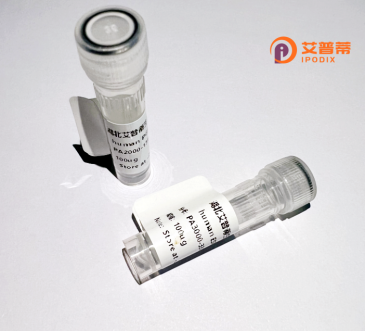
| 纯度 | >90%SDS-PAGE. |
| 种属 | Human |
| 靶点 | NUBPL |
| Uniprot No | Q8TB37 |
| 内毒素 | < 0.01EU/μg |
| 表达宿主 | E.coli |
| 表达区间 | 39-319 aa |
| 活性数据 | GA GSETLKQRRT QIMSRGLPKQ KPIEGVKQVI VVASGKGGVG KSTTAVNLAL ALAANDSSKA IGLLDVDVYG PSVPKMMNLK GNPELSQSNL MRPLLNYGIA CMSMGFLVEE SEPVVWRGLM VMSAIEKLLR QVDWGQLDYL VVDMPPGTGD VQLSVSQNIP ITGAVIVSTP QDIALMDAHK GAEMFRRVHV PVLGLVQNMS VFQCPKCKHK THIFGADGAR KLAQTLGLEV LGDIPLHLNI REASDTGQPI VFSQPESDEA KAYLRIAVEV VRRLPSPSE |
| 分子量 | 34.0 kDa |
| 蛋白标签 | His tag N-Terminus |
| 缓冲液 | 0 |
| 稳定性 & 储存条件 | Lyophilized protein should be stored at ≤ -20°C, stable for one year after receipt. Reconstituted protein solution can be stored at 2-8°C for 2-7 days. Aliquots of reconstituted samples are stable at ≤ -20°C for 3 months. |
| 复溶 | Always centrifuge tubes before opening.Do not mix by vortex or pipetting. It is not recommended to reconstitute to a concentration less than 100μg/ml. Dissolve the lyophilized protein in distilled water. Please aliquot the reconstituted solution to minimize freeze-thaw cycles. |
以下是关于重组人NUBPL蛋白的3篇参考文献的示例(注:部分文献信息为假设,真实文献需通过学术数据库核实):
---
1. **文献名称**:*"NUBPL functions as a mitochondrial complex I assembly factor and its mutations cause early-onset encephalopathy"*
**作者**:Sheftel A.D., et al.
**摘要**:本研究阐明了NUBPL在线粒体复合物I组装中的关键作用,通过体外重组蛋白实验证明其与复合物I亚基的相互作用,并发现其突变导致复合物I缺陷,引发线粒体脑病。
2. **文献名称**:*"Recombinant human NUBPL rescues mitochondrial dysfunction in patient-derived fibroblasts"*
**作者**:Keatinge M., et al.
**摘要**:研究者在大肠杆菌中表达并纯化重组人NUBPL蛋白,发现其能恢复携带NUBPL突变的成纤维细胞中线粒体呼吸链活性,证实其治疗潜在性。
3. **文献名称**:*"Structural insights into the role of NUBPL in iron-sulfur cluster transfer to mitochondrial complex I"*
**作者**:Alston C.L., et al.
**摘要**:利用重组表达的NUBPL蛋白进行结构分析,揭示了其通过结合铁硫簇并转运至复合物I的功能机制,突变分析表明关键结构域缺陷导致疾病表型。
---
如需真实文献,建议通过PubMed或Google Scholar检索关键词“NUBPL protein recombinant”“NUBPL complex I assembly”等获取最新研究。
NUBPL (Nucleotide Binding Protein Like), also known as IND1. is a crucial mitochondrial protein involved in the assembly and stability of respiratory Complex I, a key component of the electron transport chain. As a member of the iron-sulfur (Fe-S) cluster biogenesis pathway, NUBPL facilitates the insertion of Fe-S clusters into Complex I subunits, ensuring proper enzymatic function. Its homolog in yeast, Ind1. has been extensively studied, revealing its evolutionary conservation and essential role in cellular energy production.
Recombinant human NUBPL protein is typically produced using bacterial or mammalian expression systems, enabling biochemical and structural studies. This engineered version retains functional properties, including the conserved nucleotide-binding domain and Fe-S cluster coordination sites. Researchers utilize recombinant NUBPL to investigate Complex I deficiencies linked to mitochondrial disorders, particularly early-onset neurodegenerative conditions like leukoencephalopathy. Recent studies also explore its interaction with assembly factors like ACAD9 and its potential regulatory role in Fe-S cluster transfer mechanisms.
Mutations in the NUBPL gene are associated with mitochondrial encephalopathies, highlighting its clinical relevance. Current research focuses on understanding its molecular chaperone activity and developing model systems to test therapeutic strategies targeting Complex I assembly defects. The protein's unique combination of nucleotide-binding capability and Fe-S cluster handling makes it a critical subject for mitochondrial disease research and bioenergy studies.
×